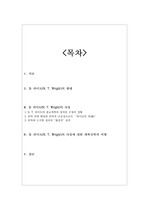

PARTNER
검증된 파트너 제휴사 자료
최후 행위심판 사상으로 본 바울신학의 새 관점 (The New Perspective on Paul and the Final Judgment According to Works)
30 페이지
최초등록일 2025.05.12
최종저작일
2010.09

-
미리보기
서지정보
· 발행기관 : 한국복음주의신약학회
· 수록지 정보 : 신약연구 / 9권 / 3호 / 409 ~ 438페이지
· 저자명 : 김경식
초록
This study aims to re-evaluate the New Perspective on Paul and its working presupposition advocated by E.P. Sanders by analyzing the idea of the final judgment according to works in early Jewish literature. This examination begins with the brief summary of E.P.
Sanders's “covenantal nomism” hypothesis and explains that the New Perspective on Paul that James Dunn and N.T. Wright strongly argue for assumes Sanders's hypothesis be the correct picture of early Judaism. Then, our study proposes to critically examine the New Perspective on Paul and Sanders's covenantal nomism in particular in terms of the final judgment according to works to check the validity of the New Perspective interpretation of Paul.
According to Sanders and other proponents of the New Perspective such as James D.G. Dunn and N.T. Wright, human obedience or the Torah observance is not taken into account at the final judgment in both early Judaism and Paul. This study deals with three pieces of early Jewish literature out of five which Sanders discussed in his book, Paul and Palestinian Judaism (Ben Sira, 1 Enoch, The Psalms of Solomon) and also investigates two additional works (11Q5 22:1-15; LAB), focusing on the idea of judgment according to works. In so doing, this article shows that Sanders's hypothesis on early Jewish soteriology called “convenantal nomism” is one-sided and thus flawed.
Our discussion demonstrates that in early Judaism human obedience played a critical role at the final judgment. However, this study also shows that not only human obedience but also God's mercy is, as Sanders has argued, the basis for the final judgment. E.P. Sanders underscores God's mercy and election while he de-emphasizes the critical role of human works at the final judgment in early judaism between BC 200 and AD 200. He also argues that human works does not contribute to the final salvation. Rather, according to him,human works does not earn God's favor and salvation because man gets in to covenantal relation with God only on the basis of divine election and he argues that human works plays a role in staying in a covenantal relation with God. However, our study of five pieces of early Jewish literature clearly demonstrates that the pattern of covenantal nomism supported by Sanders cannot explain the soteriological pattern of early Judaism correctly. This is because the early Jewish literature under consideration indicate that human works as well as divine mercy are considered crucial for the final salvation and judgment according to works. Our analysis thus demonstrates that not only the new perspective on early Judaism (E.P. Sanders) but also the new perspective on Paul (James Dunn; N.T. Wright) which accepts covenantal nomism as correct description of early Jewish soteriological pattern fail under our scrutiny.영어초록
This study aims to re-evaluate the New Perspective on Paul and its working presupposition advocated by E.P. Sanders by analyzing the idea of the final judgment according to works in early Jewish literature. This examination begins with the brief summary of E.P.
Sanders's “covenantal nomism” hypothesis and explains that the New Perspective on Paul that James Dunn and N.T. Wright strongly argue for assumes Sanders's hypothesis be the correct picture of early Judaism. Then, our study proposes to critically examine the New Perspective on Paul and Sanders's covenantal nomism in particular in terms of the final judgment according to works to check the validity of the New Perspective interpretation of Paul.
According to Sanders and other proponents of the New Perspective such as James D.G. Dunn and N.T. Wright, human obedience or the Torah observance is not taken into account at the final judgment in both early Judaism and Paul. This study deals with three pieces of early Jewish literature out of five which Sanders discussed in his book, Paul and Palestinian Judaism (Ben Sira, 1 Enoch, The Psalms of Solomon) and also investigates two additional works (11Q5 22:1-15; LAB), focusing on the idea of judgment according to works. In so doing, this article shows that Sanders's hypothesis on early Jewish soteriology called “convenantal nomism” is one-sided and thus flawed.
Our discussion demonstrates that in early Judaism human obedience played a critical role at the final judgment. However, this study also shows that not only human obedience but also God's mercy is, as Sanders has argued, the basis for the final judgment. E.P. Sanders underscores God's mercy and election while he de-emphasizes the critical role of human works at the final judgment in early judaism between BC 200 and AD 200. He also argues that human works does not contribute to the final salvation. Rather, according to him,human works does not earn God's favor and salvation because man gets in to covenantal relation with God only on the basis of divine election and he argues that human works plays a role in staying in a covenantal relation with God. However, our study of five pieces of early Jewish literature clearly demonstrates that the pattern of covenantal nomism supported by Sanders cannot explain the soteriological pattern of early Judaism correctly. This is because the early Jewish literature under consideration indicate that human works as well as divine mercy are considered crucial for the final salvation and judgment according to works. Our analysis thus demonstrates that not only the new perspective on early Judaism (E.P. Sanders) but also the new perspective on Paul (James Dunn; N.T. Wright) which accepts covenantal nomism as correct description of early Jewish soteriological pattern fail under our scrutiny.참고자료
· 없음태그
-
자주묻는질문의 답변을 확인해 주세요

꼭 알아주세요
-
자료의 정보 및 내용의 진실성에 대하여 해피캠퍼스는 보증하지 않으며, 해당 정보 및 게시물 저작권과 기타 법적 책임은 자료 등록자에게 있습니다.
자료 및 게시물 내용의 불법적 이용, 무단 전재∙배포는 금지되어 있습니다.
저작권침해, 명예훼손 등 분쟁 요소 발견 시 고객센터의 저작권침해 신고센터를 이용해 주시기 바랍니다. -
해피캠퍼스는 구매자와 판매자 모두가 만족하는 서비스가 되도록 노력하고 있으며, 아래의 4가지 자료환불 조건을 꼭 확인해주시기 바랍니다.
파일오류 중복자료 저작권 없음 설명과 실제 내용 불일치 파일의 다운로드가 제대로 되지 않거나 파일형식에 맞는 프로그램으로 정상 작동하지 않는 경우 다른 자료와 70% 이상 내용이 일치하는 경우 (중복임을 확인할 수 있는 근거 필요함) 인터넷의 다른 사이트, 연구기관, 학교, 서적 등의 자료를 도용한 경우 자료의 설명과 실제 자료의 내용이 일치하지 않는 경우
“신약연구”의 다른 논문도 확인해 보세요!
-
“마음에 심긴 도를 온유함으로 받으라”: 야고보서 1:21b의 신학적 중심성 51 페이지
`Faith and Work' is not the only, and perhaps not the main,theological thread in the letter of James. Recent scholarship pays more attention, in their seeking any theology of James, to chapter one rat.. -
“말하다” 동사의 분사형의 한국어 번역에 대하여 23 페이지
When participles of SAYING verbs (e.g. le,gwn) are translated,scholars have frequently faced interpretative difficulty because their semantic domains are overlapped with those of main verbs in a sente..
찾으시던 자료가 아닌가요?
지금 보는 자료와 연관되어 있어요!
문서 초안을 생성해주는 EasyAI


